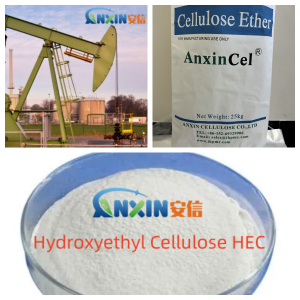Hydroxyethyl cellulose (HEC) is an important nonionic cellulose ether, produced from natural cellulose through alkalization and etherification reactions. It possesses excellent thickening, film-forming, stability, and salt resistance. Due to its unique physicochemical properties, HEC plays multiple roles in oil drilling fluid systems, including efficient thickening, reducing filtration loss, proppant carrying, and rheological regulation, making it an indispensable multifunctional additive in modern drilling engineering.
1. Performance Characteristics of HEC and its Suitability for Drilling Fluid Systems
1.1. Nonionic Characteristics and Good System Compatibility
HEC molecular structure does not contain charged groups, and it does not react with clay, organic amines, salts, etc., in drilling fluids. It is suitable for freshwater, brine, seawater, and saturated brine systems. Its good system compatibility makes fluid preparation more stable and reduces performance fluctuations.
1.2. Excellent Thickening and Rheological Control Performance
HEC significantly improves the viscosity, thixotropy, and yield strength of drilling fluids, optimizing rheological profiles and giving the drilling fluid better bottomhole proppant carrying capacity, formation lubrication, and suspension capabilities, ensuring drilling stability.
1.3. Strong Salt and Electrolyte Resistance
Compared to anionic colloids, HEC maintains stable viscosity in formations with high calcium, magnesium, and salt content, and is less prone to degradation or precipitation, making it particularly suitable for high-salinity drilling fluids and offshore drilling operations.
1.4. Excellent Filtration Control Performance
HEC forms a dense filter cake on the wellbore, reducing drilling fluid water infiltration into the formation, thereby effectively reducing cake thickness, minimizing wellbore instability risk, and contributing to improved wellbore stability.
2. Key Roles of HEC in Different Drilling Fluids
2.1. Role in Freshwater Drilling Fluids
In conventional freshwater drilling fluids, HEC significantly improves viscosity, thickens, and enhances sand-carrying capacity. Its high solubility and easy dispersion allow it to form a homogeneous system quickly, improving rheological parameters and enabling rapid removal of drill cuttings from the wellbore, preventing sand accumulation and stuck pipe accidents.
2.2. Application in Seawater and Brine Drilling Fluids
Seawater and brine have high ionic content, which significantly degrades most water-soluble polymers. HEC nonionic structure provides excellent salt stability.
Its functions include:
Maintaining viscosity from degradation in high-salt environments;
Maintaining good filtration control under brine conditions;
Preventing the structural damage caused by salt precipitation.
Therefore, HEC is particularly valued in offshore drilling, where it can be used as a thickener, filtration reducer, and stabilizer.
2.3 Performance in High-Density Drilling Fluids
High-density drilling fluids have a high solids content, making rheological control difficult. HEC highly efficient viscosity-enhancing ability can improve the suspension capacity of high-solids systems while reducing friction between solid particles, thus improving the shear stability of the drilling fluid.
3. Main Functions of HEC
3.1. Viscosity Enhancement and Props Carrying
HEC can increase plastic viscosity and yield value, enabling the drilling fluid to maintain stable viscosity under high shear and moderate thixotropy under low shear, improving proppant carrying and suspension effects, ensuring drill cuttings are promptly carried out of the wellbore, and preventing wellbore deposition.
3.2. Filtration Control and Wellbore Protection
Its molecular chains form a uniform, dense filter cake on the wellbore, reducing mud fluid water loss, thereby:
Reducing formation water absorption and swelling;
Preventing wellbore collapse and wellbore enlargement;
Improving wellbore pressure resistance.
3.3. Stabilizing Drilling Fluid Systems
The polymer structure of HEC can adsorb onto the surface of drilling fluid particles, enhancing the colloidal stability of the system and reducing flocculation and sedimentation, thereby maintaining the long-term stability of the drilling fluid。
3.4. Lubrication and Friction Reduction
HEC smooth and flexible molecular chains effectively reduce friction between the drilling fluid and drill pipe, improving lubrication, helping to reduce torque and friction, and increasing drilling efficiency, especially suitable for deep wells and horizontal wells.
4. Precautions for Use
4.1. Dispersion Method
HEC should not be added directly to water. It should be added while stirring to prevent clumping from affecting the dissolution rate.
4.2. Dissolution Temperature Control
The suitable temperature is 20–35℃. Excessively high temperatures may lead to uneven dissolution or performance fluctuations.
4.3. Dosage Recommendations
The usual addition amount is 0.3%–1.0%, adjusted according to rheological requirements.
HEC plays a vital role in the oil drilling fluid field due to its unique nonionic structure, high-efficiency thickening properties, excellent salt resistance, and stable rheological properties. Whether it is freshwater drilling fluid, brine system, or complex formation and high-density mud system, HEC can significantly improve the sand carrying capacity, filtration reduction, and lubrication performance of drilling fluid, making it an indispensable key material for ensuring safe and efficient drilling.
Post time: Nov-14-2025








